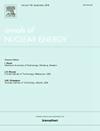Development and validation of NECP-SARAX: An advanced neutron analysis code system for accelerator-driven subcritical systems
IF 1.9
3区 工程技术
Q1 NUCLEAR SCIENCE & TECHNOLOGY
引用次数: 0
Abstract
An accelerator-Driven Subcritical System (ADS) is a facility that utilizes high-energy spallation neutrons to transmute minor actinide nuclides and long-lived fission products, supporting the “partitioning and transmutation” strategy. However, the energy of spallation neutrons can reach hundreds of megaelectron volts, which represents a huge challenge to the deterministic neutron transport methods. To address this challenge, NECP-SARAX, an advanced neutron analysis code system, has been developed by the Nuclear Engineering Computational Physics Laboratory, Xi’an Jiaotong University. To apply NECP-SARAX code in the ADS, the influence of high-energy spallation neutrons on the system was evaluated as the first step. Next, SARAXLIB-HE, a high-energy neutron database, was established based on high-energy evaluation databases JENDL4.0-HE, JENDL-HE-2007, and IAEA-ADS-HE. To address neutron leakage and the impact of external sources, the NECP-SARAX code has been enhanced by incorporating a fixed source transport solver for fission materials during the process of generating few-group cross-sections. Finally, verifications of assembly and reactor benchmarks demonstrated that the SARALIB_HE database and the SARAX code are suitable for calculating and analyzing the ADS.
求助全文
约1分钟内获得全文
求助全文
来源期刊

Annals of Nuclear Energy
工程技术-核科学技术
CiteScore
4.30
自引率
21.10%
发文量
632
审稿时长
7.3 months
期刊介绍:
Annals of Nuclear Energy provides an international medium for the communication of original research, ideas and developments in all areas of the field of nuclear energy science and technology. Its scope embraces nuclear fuel reserves, fuel cycles and cost, materials, processing, system and component technology (fission only), design and optimization, direct conversion of nuclear energy sources, environmental control, reactor physics, heat transfer and fluid dynamics, structural analysis, fuel management, future developments, nuclear fuel and safety, nuclear aerosol, neutron physics, computer technology (both software and hardware), risk assessment, radioactive waste disposal and reactor thermal hydraulics. Papers submitted to Annals need to demonstrate a clear link to nuclear power generation/nuclear engineering. Papers which deal with pure nuclear physics, pure health physics, imaging, or attenuation and shielding properties of concretes and various geological materials are not within the scope of the journal. Also, papers that deal with policy or economics are not within the scope of the journal.
 求助内容:
求助内容: 应助结果提醒方式:
应助结果提醒方式:


